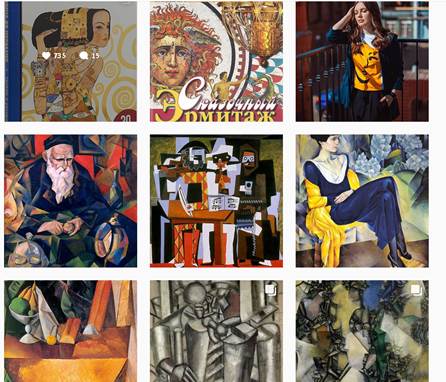Abstract
The article describes the use of Internet technologies for working with parents of children of senior preschool age in order to form a positive evaluative attitude towards works of art among preschoolers. Modern emergences in older preschool children caused by the “information explosion” are shown, while the importance of the aesthetic development of the preschool child in the modern information society is highlighted. Much attention is paid to the emotional reaction of the child as a marker of a positive evaluative attitude to works of art. This is manifested in a decrease in children's interest in works of art, as well as a rapid reduction in free time among parents of preschool children, with simultaneously growing opportunities for online communication and a high need for advisory assistance from a mentor. The features of the presentation of the material in the process of working with parents on social networks Facebook and Instagram are analyzed. The methods of working with the family of a preschooler in social networks are considered when forming a positive evaluative attitude to art in children. A fragment of an online quiz with families of children of preschool age and a subsequent online survey of parents of preschool children is presented. The purpose of the survey was to identify among older preschoolers a sustained interest in works of art. Sustained interest indicates the formation of a positive evaluative attitude to the visual arts in children of preschool age.
Keywords: Preschooleraesthetic developmentworks of artpositive evaluative attitudeInternet technologies
Introduction
Thanks to the “information explosion”, society is currently undergoing changes that affect not only adults and adolescents, but also preschool children. The Internet has become part of modern reality, integrated into all spheres of life. The consequence of this was a decrease in interest in the visual arts in the adult population, which makes it difficult for children to form a positive evaluative attitude to works of art. This stimulates a scientific search in the field of aesthetic education of the child, in particular, the development of technologies adequate to the modern information society, which form a positive attitude towards works of art in children (Garapuchik, Strelbitskaya, & Bokareva, 2014).
In these conditions, there is a need to revise pedagogical technologies for working with the family and use the capabilities of the Internet for the artistic development of older preschoolers (Zubareva, 1969).
Problem Statement
The " Strategy for the Development of Upbringing in the Russian Federation for the period until 2025" outlines the importance of the formation and development of preschool children in the context of spiritual, moral and aesthetic ideals of artistic taste and evaluation criteria. Unfortunately, today, older preschool children, along with positive ones, have a number of negative emergences: “clip thinking” with a weakening of empathy, responsibility and distortion of the core of the personality; dehumanization of relations in general; inhibition of the physical and intellectual development of children (Feldshtein, 2013). The aforementioned situation can be corrected by aesthetic education, in particular, familiarization of older preschool children with works of fine art and the formation of the prerequisites for its value-semantic understanding in them. Thus, it is necessary to determine what are the most optimal content, forms and methods for developing a positive evaluative attitude to works of fine art in children of preschool age in the modern information environment.
Research Questions
The task of a teacher working with children is to introduce them to the basics of fine art using various means of artistic expression. They can be mental images, comparisons, literary turns. As a result, a child not only studies visual art and forms his opinion about it, but also learns to express his own emotions and describe feelings (Kazakova, 2008).
A marker of a positive evaluative perception of works of art by senior preschoolers is an emotional reaction to works of art, which manifests itself in the fact that children show pleasure, joy, interest; are passionate about viewing; demonstrate the expressive-mimic manifestation of emotions in the process of perception of a work of art; accompany movements with the process of perception of a work of art; independently give a moral, aesthetic, verbal assessment of the works; use epithets, metaphors, and hyperbolas when assessing the works (Karpova, 2015).
Modern parents of older preschoolers, having the desire to receive counseling, do not find time for frequent meetings with the teacher, but they willingly interact with him on the Internet and perform tasks together with the children.
The authors developed a technology for interactive interaction with families of children of preschool age in the Internet environment to form a positive evaluative attitude towards visual art among preschoolers, the peculiarity of which is the use of social networks as a base for competitions, quizzes, marathons, live broadcasts, podcasts, virtual tours etc. on the theme of art. The proposed materials contain reproductions of paintings, their descriptions and tasks for them, as well as test questions (Levshina, 1983).
Purpose of the Study
The purpose of the study was to develop a technology for the development of a positive evaluative attitude to works of fine art in children of preschool age, taking into account the modern information environment.
Research Methods
The study involved 76 parents of children of preschool age who are active users of social networks Facebook and Instagram.
The content of the content on Instagram is similar to the Facebook content, the only difference is the platform-specific ways of submitting material: if on Facebook this is an illustrated article (possibly with a video file), then on Instagram it is an illustration and/or video with a signature. Parents’ preference of Instagram over Facebook may mean the prevailing imaginative perception of modern adult young people, which we suggest taking into account when designing work with parents of preschool children (Figure


Instagram features allow connecting this platform with Facebook and duplicate posts in it.
This allows increasing your reach. So, in the quiz related to the image of the apple in works of art of various genres, both Facebook subscribers and Instagram took part.
For two weeks, we posted posts on Instagram, duplicating them on Facebook. The posts covered six themes related to the image of the apple (mythology, biblical subjects, still lifes, Dutch still-lifes, Archimboldo's art, twentieth-century art). Materials containing reproductions of paintings, their descriptions and assignments were sent to participants' e-mails. Parents of preschoolers read, printed reproductions, and then had conversations with their children and completed assignments. The last, seventh, post contained the final test on all topics. The winners, in addition to the prizes, received flyers for educational quests at the A.S. Pushkin State Museum of Fine Arts (Pushkin Museum) and the Tretyakov Gallery, where they could consolidate their knowledge on examples of real works of various authors and eras.
The online quiz aroused great interest of children and parents, which allows talking about the prospects of this form of work with the family of a preschooler (Chumicheva, 1992).
As a result of our work, we conducted an online survey of parents participating in the experiment thirty days after the end of the quiz. The survey contained three questions.
The purpose of the first question was to identify the interest of senior preschoolers in the works of fine art during the quiz. The question was as follows: "On a scale of 1 to 3, rate the child’s interest in reproductions of paintings in the process of completing quiz tasks: 1 – low, 2 – medium, 3 – high."
7 parents (9.2 %) responded that the child’s interest was low, 50 people (65.8 %) noted the average interest and 19 people (25 %) mentioned the child’s high interest.
The second question, “Rate on a scale of 1 to 3 points, the child’s interest in reproductions of paintings in the process of completing quiz tasks: 1 – low, 2 – medium, 3 – high”, was aimed to identify the interest of senior preschool children in the works of fine art during quiz.
3 parents (3.95 %) answered that the child’s interest remained low, 30 people (39, 47 %) indicated an average interest and 43 respondents (56.58 %) noted a high interest of the child.
The purpose of the third question was to identify the interest of senior preschoolers in the works of art after the quiz was over. The question was as follows: "Rate on a scale of 1 to 3 points the child’s interest in reproductions of paintings at present: 1 – low, 2 – medium, 3 – high."
4 parents (5.26 %) noted the low interest of the child, 40 people (52.63 %) noted the average interest and 32 people (42.11 %) noted the high interest of the child.
Thus, there is an increase in the interest of senior preschool children in works of art. The number of children with high interest increased by the end of the experiment from 25 % to 42.11 % (by 17.11 %).
Findings
After analyzing this information, the authors came to the conclusion that a steady increase in the interest in works of fine art among older preschoolers can be observed as a result of the use of Internet technologies as a means of creating a positive evaluation attitude towards fine art in children.
Conclusion
Thus, when using social networks as a tool for forming a positive evaluative attitude to the visual arts in senior preschool children, conditions are created for implementing the mechanism of the formation of the child’s behavior from observation (passive) to experiencing, understanding, evaluating and choosing an own attitude. Systematic and consistent use of Internet technologies in working with parents of a senior preschooler contributes to the formation of a positive evaluative perception of art in a child, and also contributes to his artistic development.
References
- Chumicheva, R. M. (1992). Informing preschoolers about art. Moscow, Prosveshcheniye Educat. Holding.
- Feldshtein, D. I. (2013). The functional load of the Academy of education in determining the principles and conditions for the development of a growing person at a historically new level of society movement (report at the General meeting of RAO 29. 10. 2013). Probl. of modern ed., 6–20.
- Garapuchik, E. V., Strelbitskaya, I. A., & Bokareva, E. V. (2014). Preschool age children familiarization with works of art. Young scientist, 14, 284–286.
- Karpova, U. V. (2015). Pedagogical diagnostics of individual development of the 3–7 years old child. Methodical manual. Moscow: Ventana-Graf.
- Kazakova, R. G. (2008). Drawing classes with preschoolers. Moscow: TC Sfera.
- Levshina, I. S. (1983). How a work of art is perceived. Moscow: Znaniye Publ. House.
- Zubareva, N. M. (1969). Children and fine art. Moscow: Educat. Publ. House.
Copyright information

This work is licensed under a Creative Commons Attribution-NonCommercial-NoDerivatives 4.0 International License.
About this article
Publication Date
31 October 2020
Article Doi
eBook ISBN
978-1-80296-091-4
Publisher
European Publisher
Volume
92
Print ISBN (optional)
-
Edition Number
1st Edition
Pages
1-3929
Subjects
Sociolinguistics, linguistics, semantics, discourse analysis, translation, interpretation
Cite this article as:
Magomedovna, M. V., Alexeevna, T. V., Aleksandrovna, R. N., Nikolaevich, K. N., & Vladimirovna, K. A. (2020). Formation Of A Positive Attitude To Art In Preschoolers Using Internet Technologies. In D. K. Bataev (Ed.), Social and Cultural Transformations in the Context of Modern Globalism» Dedicated to the 80th Anniversary of Turkayev Hassan Vakhitovich, vol 92. European Proceedings of Social and Behavioural Sciences (pp. 3180-3184). European Publisher. https://doi.org/10.15405/epsbs.2020.10.05.422

